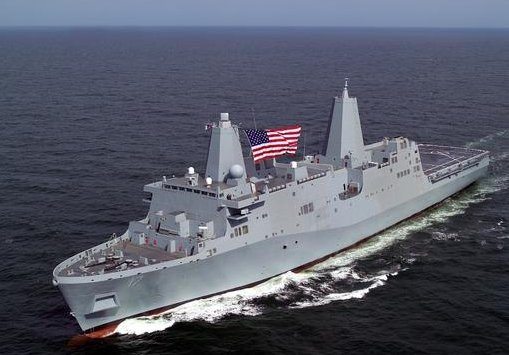Results from a test simulating a chemical attack aboard USS New York (LPD 21) off the coast of Virginia verify the effectiveness of chemical, biological and radiological (CBR) defense systems in protecting Sailors aboard San Antonio-class ships, the Navy announced Jan. 31.
According to the Defense Department Operational Test and Evaluation Force report, the San Antonio amphibious assault ship class can operate in a chemical warfare environment protected by various CBR defense systems, including the Improved Point Detection System – Lifecycle Replacement (IPDS-LR) technology.
“The report provides high level verification of the effectiveness of our collective protection system, IPDS-LR, countermeasure washdown, decontamination stations and casualty decontamination stations,” said Michael Pompeii, Naval Surface Warfare Center (NSWC) Dahlgren CBR Defense Division chief engineer.
His team of NSWC Dahlgren CBR defense engineers assisted the Navy Operational Test and Evaluation Force throughout the March 2012 event to fulfill operational test and evaluation requirements for the San Antonio class.
“Every new class of ships that the Navy builds undergoes rigorous testing to validate that the operational requirements are met,” said Jay Stefany, executive director of the Program Executive Office for Ships Amphibious and Auxiliary Sealift programs, the organization that directed and funded the testing. “The CBR defense test on USS New York was the final major operational test event for the LPD 17 class, and we are very pleased with the performance of the CBR defense systems.”
A helicopter flew over the amphibious assault vessel at 300 feet while spraying a simulated, personnel-safe, chemical weapon to simulate an attack. USS New York and its CBR defense systems responded effectively to the simulated chemical warfare environment. In addition, the crew launched two landing craft, air-cushioned vehicles, demonstrating their ability to conduct amphibious operations in a contaminated environment.
“The IPDS-LR detected a vapor cloud of chemical agent simulant prior to its contact with the ship,” wrote J. Michael Gilmore, DoD director of Operational Test and Evaluation (DOT&E) in the report.
The Navy plans to install the new system – designed to quickly alert warfighters to the presence of chemical warfare agents – on all active guided-missile destroyers and cruisers, aircraft carriers, large and small deck amphibious ships, littoral combat ships and dry cargo/ammunition ships by the end of 2018.
“Additionally, the chemical [collective] protective system prevented entry of simulant vapors into protected zones of the ship,” Gilmore stated in his report.
Designed to protect personnel and equipment inside ships from CBR attacks, the chemical protective system (CPS) works by using special filters to remove contaminants from intake ventilation air and provides a slight overpressure inside the CPS zone to prevent entry of contaminants through any leak paths. In a typical CPS zone aboard a ship, contaminated outside air is drawn in, cleaned by special filters and distributed throughout the zone.
New York’s countermeasure wash down system also efficiently washed the ship’s exterior from contaminants in the fictitious CBR event, and the ship’s decontamination and casualty decontamination stations – designed to efficiently remove any contamination from personnel entering the ship – also worked effectively.
“The test sets a new precedent of using our helicopter-mounted chemical simulant sprayer and referee equipment for future ship CBR defense tests,” said Pompeii.
Amphibious transport dock ships are warships that embark, transport and land elements of a landing force for a variety of expeditionary warfare missions.
The San Antonio-class ships include those based in Norfolk: USS New York, USS San Antonio (LPD 17) and USS Mesa Verde (LPD 19). USS New Orleans (LPD 18), USS Green Bay (LPD 20), USS San Diego (LPD 22) and USS Anchorage (LPD 23) are based in San Diego.
Three San Antonio-class ships are currently under construction: Somerset (LPD 25), John P. Murtha (LPD 26) and the yet-unnamed LPD 27. LPD 24 (Arlington) delivered to the Navy in December 2012 and is scheduled to arrive in its homeport of Norfolk, Va., in spring 2013.
“The Navy’s CBR Defense division exists to provide our warfighter with the tools and capabilities necessary to detect, protect, and if necessary, decontaminate threats resulting from a CBR attack,” said NSWCDD CBR Defense Division Head Mike Purello. “Our direct and active connection with the fleet helps the warfighter and provides a wealth of valuable information for our scientists and engineers in the lab. This knowledge is immediately put to use as they work to create, develop and provide updates and future solutions for our men and women in uniform.”










